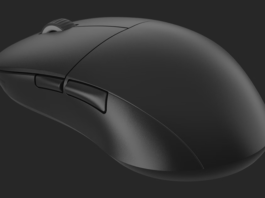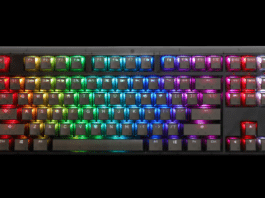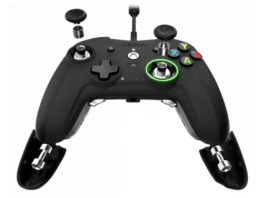Introduction & Specifications
In the world of PC gaming, there’s very few occasions where a manufacturer can claim to include a feature “first” in the marketplace. So when a mouse arrives in the office claiming to be “armed with the first fully customisable OLED display…”, then it deserves our full attention.
The company is SteelSeries, and the mouse in question is the Rival 700. It’s being heralded as the most powerful gaming mouse on the market, and from looking at the specifications alone, it’s hard to argue!
Design |
|
| Material | Matte Top Cover |
| Shape | Ergonomic, Right-Handed |
| Grip Style | Palm, Claw, and Fingertip |
| Number of Buttons | 7 |
| SteelSeries Switches | Rated for 30 Million Clicks |
| Weight | 135g, 0.3 lbs |
| Height | 124.85mm, 4.92in |
| Width | 68.46mm, 2.70in |
| Depth | 41.97mm, 1.65in |
| Short Cable Length (non-braided) | 1m, 3.28 ft |
| Long Cable Length (braided) | 2m, 6.5 ft |
Sensor |
|
| Sensor Name | PixArt PMW3360 |
| Sensor Type | Optical |
| CPI | 100 to 16,000 |
| IPS | 300 |
| Acceleration | 50g |
| Polling Rate | 1 ms (1000 Hz) |
| Zero Hardware Acceleration | |
| Tracking Accuracy | 1:1 |
Customization Options |
|
| Gamesense Support | |
| OLED Display Customization | |
| Tactile Alert Customization | |
| SteelSeries Engine Support | |
| Onboard Profile Settings | |
| Programmable Buttons | |
| Acceleration Customization | |
| Deceleration Customization | |
| Multiple CPI Options | |
| Colour Options | 16.8 Million |
| Swappable Pixart 9800 Laser Sensor | |
| Swappable Rival 700 Top Cover Pack | |
| Printable 3-D Nameplate | |
Closer Look
The Rival 700 outer packaging is unmistakably SteelSeries, with its striking black & orange appearance. The front is dominated by a nice clear image of the mouse itself, along with the main features highlighted; these being the OLED screen, tactile alerts and Prism RGB.
The design applied to the rear of the packaging takes the form of another picture of the mouse, but this time annotated with slightly more detailed descriptions of the product features.
This outer design is all part of a sleeve that when removed, reveals a fairly minimalistic black box, with an angular opening on a hinge. Flip it up and you are greeted with the mouse itself, along with its accessory box, both neatly nestling inside.
The accessories consist of 2 removable USB cables; one short & one long, and the instruction manual.
Getting to grips with the mouse itself, and from my own personal perspective, it’s a very good looking item. Predominantly black in appearance, the rear removable shell (more of that later) features a geometric patterned design, made up of lots of small triangles. Sitting at the base of this shell is a large SteelSeries logo, which will no doubt light up in operation. To the left hand side we have two configurable buttons, which for my personal liking were perfectly placed for thumb use.
In front of the removable shell we have the standard layout of left & right click buttons, with scroll wheel & DPI selector sat between them… nothing revolutionary here then, but to be honest, there is no need for there to be. With the Rival 700 not being ambidextrous, no buttons feature on the right hand side, and is therefore completely covered with a rubberised texture.
To the left hand side we have two configurable buttons in a familiar position, plus a third positioned below these, butted up to the OLED screen. Further rubberised material finishes of the side of the mouse where all the action happens!
Rolling the mouse over to look at the underside, we get to see optical module, which is actually modular. Supplied as standard is the PixArt PMW3360, but you will also have the chance to swap this out for the Laser 9800 module as detailed on the SteelSeries website.
Whilst we take a look at the underneath, we can also see the port for the swappable cables that come packaged with the Rival 700 as standard.
Our closer look concludes with more modular options, in the form of the top shell having the ability to be removed & swapped out for a different design, along with a removable nameplate. The neat thing about the nameplate, is that SteelSeries offer the user the ability to download the necessary files to 3D print your own! Totally unnecessary, but very cool!
Software
The software you’ll need to control & manipulate your Rival 700 is SteelSeries Engine 3, and it provides a one-stop shop for all your SteelSeries peripheral needs. You can download it from HERE.
First up is the My Gear tab, which lists all the enabled SteelSeries peripherals connected to your computer.
Clicking your device, takes you to the screen where you can perform all your customisations… and in the case of the Rival 700, boy are there a lot to play with here! Changing LED illumination colour, DPI settings, and button actions is a given, but there is so much more there for the tweaking with this mouse; acceleration & deceleration, angle snapping, polling rate, numerous tactile settings based on button clicks or in game experiences… the list is extensive.
Perhaps the feature I’ve spent most time playing with in my short time with the Rival 700 is the OLED screen. Okay, it’s not 1080P or anything, and there is a yellow tinge to the display, but the possibilities are endless. In game stats (dependent upon the game being supported), sensitivity settings and button mapping flash up… or upload any design you want. Is it useful? I’ll tell you later!
Next up is the Library tab. As the name suggests, this is where you can track of all your games & applications, and have a default configuration automatically load when the game or application is in use. Adding new items is very easy, and involves just browsing to its location on your hard drive.
The final tab is GameSense, and this is where things get really interesting. Under the first sub tab, we can change the way in which the illumination of the mouse changes in game, and in our example we have chosen CS:GO. The best example of how this works is your in-game health, with the scroll wheel displaying the relevant shade of red or green based on your proximity to a painful death!
Moving on now to the Tactile sub-tab. As with the previous screen that changed the lighting effects based on the in-game action, here vibration patterns that emanate from the mouse are configured. One of the examples shown below is a long buzz when you meet your maker.
Our final screen in this whistle stop demonstration of the wealth of features we have at our disposal here, is the screen sub-tab. This is used for changing what the screen on the side of the mouse displays. You can make it display a range of info such as the amount of kills in a round, the score your team currently has or just a custom image.
Performance & Testing
Under normal operation using desktop applications (such as writing this review) the Rival 700 provides a pleasurable experience. The real test however is how it performs during gameplay.
Whilst testing the mouse out playing CS:GO, the Rival 700 performed very well. The tracking was accurate, and there was no noticeable lag at all. All buttons were in easy reach, and it was comfortable to use (assuming you are right handed)!
I was worried that the tactile feedback options may be distracting during gameplay, but to be honest it wasn’t that bad… if not a little strange to begin with. The force feedback through the unit is fairly subtle, so don’t expect the violent vibrations you would likely experience using a console gamepad. Unless the amount of games that are compatible with this haptic feature increases however, it’s likely to be consigned to a sideshow gimmick, and most people will turn it off completely.
Whilst the OLED screen provided interest whilst setting up the Rival 700, in all honesty it’s usefulness during gaming is pretty limited. Don’t get me wrong, the functionality works flawlessly, but even if you had the time to glance at the screen during an intense gunfire exchange, the screen was mostly shielded by my hand anyway.
One element of the Rival 700 that split opinion in the office, was the weight of the mouse. I for one found the weight really nice. It is heavier than most, but I came to terms with that immediately, and actually preferred it to my everyday workhorse. One of my Play3r colleagues however, didn’t like the additional weight at all. The best advice I can give, is try to get some hands on time, and test it out for yourself.
Conclusion
There is no doubting that the SteelSeries Rival 700 is a premium product. The materials used are top notch, the features it packs all work perfectly and the performance right up there too. Some of the aforementioned features are more useful than others, but nonetheless they all do exactly what they advertise. The SteelSeries Engine 3 software is also easy to use, and is extremely intuitive, guiding you through all the various ways to configure your mouse to your specific taste.
However, lets address the elephant in the room… it’s not cheap, it’s actually quite expensive if you believe the RRP on the SteelSeries site, which pitches the Rival 700 at £89.99 at the time of this review. Thankfully, we did find it for a shade under £65 at eBuyer, which actually makes it a pretty decent buy in my opinion. If you then want to add any of the modular items though, such as the swappable covers, then you will need to throw more cash at it.
Taking all of the above into consideration, I’m going to give the SteelSeries Rival 700 the Play3r Gold Award. It is expensive, and there are better options for sheer value for money, but this is a top performer, with high end features. I really like this mouse… and I’m keeping it as my daily driver.
Purchase from Ebuyer UK: £64.94
Massive thanks to SteelSeries for sending the Rival 700 in for review.
-
Performance
-
Design
-
Value
Summary
Pros:
– Premium build quality
– Comfortable ergonomic design
– SteelSeries Engine 3 software easy to use
– Tactile feedback & OLED screen
Cons:
– RRP is expensive, but can be bought for much less
– Limited support for GameSense





















